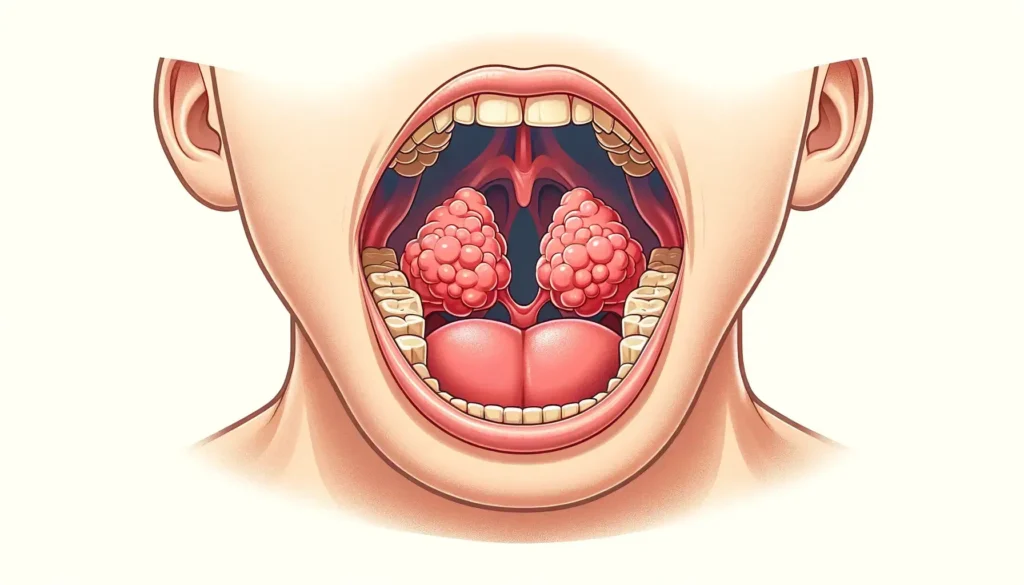Tonsillectomy is a surgical procedure to remove tonsils. It is common to get it done for treating recurrent throat infections and obstructive sleep apnea. Yet, a question lingers: can tonsils grow back after being removed? – tymoff.
A simple answer to that would be no they usually don’t grow back. However under certain circumstances, like residual tissue being left behind, there are chances for tonsils to grow back.
Understanding tonsil regrowth is crucial, for those who have undergone or are considering a tonsillectomy. So, Let’s further discuss at length what this surgical technique involves in removing tonsils and whether they can grow back or not.

Tonsillectomy: A Quick Overview
Tonsillectomy is the surgical removal of the tonsils, two small masses of lymphatic tissue located at the back of the throat. This procedure is typically recommended for individuals suffering from recurrent tonsillitis or obstructive sleep apnea.
The main goal of a tonsillectomy is to alleviate symptoms such as sore throat, difficulty swallowing, and sleep disturbances. Despite its effectiveness, the surgical procedure can vary from person to person.
It can range from complete removal to partial (tonsillotomy), depending on the individual’s condition and the surgeon’s approach.
Brief on the Tonsillectomy Procedure.
The surgical procedure for tonsillectomy involves careful removal of tonsil tissue while minimizing damage to surrounding areas. The method is chosen by the healthcare professional, whether traditional scalpel, laser, or radiofrequency.
However, the procedure itself can influence the healing process and the likelihood of residual tissue being left behind. This residual tissue may pave the way for potential regrowth, albeit in rare cases, which underscores the importance of a thorough surgical technique.
The Tonsillectomy Procedure Explained
Tonsillectomy involves the removal of the tonsils, but the exact approach can vary and significantly impact the likelihood of any tissue being left behind, which in turn affects the chances of regrowth.
How Tonsils Are Removed
Surgeons can remove tonsils using various techniques, including cutting them out with a scalpel, burning them away with a laser, or vaporizing them with radiofrequency energy.
Each method aims to remove as much tonsil tissue as possible to prevent the issues that led to the need for surgery.The choice of technique depends on the surgeon’s preference, the patient’s health status, and the specific reasons for the tonsillectomy.
Read Also: Build Insane Triceps By Doing Skull Crushers – Laz – Tymoff: Guide 2024
Residual Tissue and Its Implications
Despite the surgeon’s best efforts, sometimes small pieces of tonsil tissue are left behind. This residual tissue can potentially regrow, especially if it receives the right “triggers,” such as infections or chronic inflammation. The amount of tissue left and its location can vary, making some cases more prone to noticeable regrowth than others.
Tonsil Tissue Regrowth: Can Tonsils Grow Back After Being Removed? – Tymoff
The notion that tonsils can grow back after being removed is both intriguing and concerning. Tonsil regrowth primarily occurs when small amounts of tonsil tissue are left behind after the procedure, which can regenerate over time. However, it’s important to note that this is relatively rare and typically associated with incomplete removal during the initial surgery.
Several factors influence the possibility of tonsil regrowth. Age plays a significant role, as younger patients have a higher likelihood due to their robust healing capacities and the regenerative nature of lymphatic tissues.
Additionally, the type of surgical procedure—complete tonsillectomy versus partial removal (tonsillotomy)—significantly affects regrowth chances. Infections and inflammation in the throat post-surgery can also contribute to the regrowth of residual tonsil tissue.

Factors Influencing Tonsil Regrowth: Explained
Understanding the factors contributing to tonsil regrowth can help manage expectations and outcomes post-surgery.
Age and Its Impact
Younger patients have a higher chance of tonsil regrowth. Children and adolescents’ bodies are in a rapid growth phase, including their lymphatic tissue, making them more prone to regrowth.
Surgical Techniques: Tonsillectomy vs. Tonsillotomy
The type of surgical procedure plays a significant role. A complete tonsillectomy, where all the tonsil tissue is removed, has a lower risk of regrowth compared to a tonsillotomy, where only part of the tonsil is taken out. The remaining tissue in tonsillotomy can potentially regrow.
Influence of Allergies and Infections
Post-surgery, the throat is susceptible to infections and inflammation, which can stimulate the residual tonsil tissue to regrow. Moreover, individuals with allergies might experience chronic inflammation, contributing to the likelihood of tonsil regrowth.
Recognizing the Signs of Tonsil Regrowth
After a tonsillectomy, the thought of tonsils growing back might not even cross your mind. However, understanding and recognizing the signs of potential regrowth is important. This knowledge can help in seeking timely medical advice and intervention if needed.
Symptoms Indicating Regrowth
The most common signs that suggest your tonsils might be making a comeback include;
- recurrent throat infections,
- a sore throat, and
- discomfort similar to what was experienced before the tonsillectomy.
- You might also notice difficulty swallowing or a feeling of something being “stuck” in your throat.
These symptoms are clues that should prompt a visit to a healthcare provider.
Differentiating Between Original and Regrown Tonsils
Regrown tonsils might not look or behave exactly like the original ones. They often appear as smaller, less defined masses of tissue at the back of the throat. This distinction is crucial for healthcare providers when evaluating symptoms and deciding on the next steps for management.
Seeking Medical Attention
On noticing symptoms that suggest tonsil regrowth, it’s important to visit a healthcare practitioner. A healthcare provider can perform a physical examination and possibly order imaging studies to confirm if regrowth has occurred. Early detection is key to managing any potential issues effectively, including deciding if further medical or surgical intervention is necessary.
The Immune Significance of Tonsils
Tonsils are not just random tissue in the back of the throat; they play a pivotal role in the body’s immune system. Acting as the first line of defense against airborne pathogens, tonsils help in producing antibodies to fight infections. However, when they become more of a liability than an asset due to recurrent infections or other health issues, removal might be recommended.
Role of Tonsils in the Immune System
The tonsils are part of the lymphatic system, which is integral to the body’s immune response. They help detect and fight infections by trapping pathogens that enter through the mouth or nose. Despite their removal, the body can still fight infections effectively, thanks to other components of the immune system.
Impact of Tonsil Removal on Immune Function
Concerns often arise about the potential impact of tonsillectomy on immune function. Research suggests that while tonsils play a role in the immune system, their removal does not significantly compromise the body’s ability to fight infections. The immune system is adaptable and can adjust to the absence of the tonsils.

Addressing Tonsil Regrowth: Treatment Options
When tonsils regrow after a tonsillectomy, it can be both surprising and concerning. Understanding the treatment options available is essential for managing this situation effectively.
Management and Treatment Options for Regrown Tonsils
Treatment for regrown tonsils depends on the symptoms they cause. If the regrowth leads to recurrent infections or obstructive symptoms similar to those before the initial surgery, a second tonsillectomy might be considered. However, not all cases of regrowth require surgery. Sometimes, watchful waiting or treating individual infections with antibiotics might be recommended.
When a Second Tonsillectomy Might Be Necessary
A second tonsillectomy is typically considered only if the regrown tonsils cause significant health issues. The decision is made based on a thorough evaluation of symptoms, the frequency of infections, and the overall impact on the patient’s quality of life. This procedure, like the first tonsillectomy, is carried out to alleviate symptoms and improve health outcomes.
FAQs – Can tonsils grow back after being removed? – tymoff
Can Tonsils Grow Back Fully After Being Removed?
While complete regrowth of tonsils after a total tonsillectomy is rare, partial regrowth is possible, especially if some tonsil tissue is left behind. The extent of regrowth can vary and is influenced by factors such as the surgical technique used and the individual’s healing process.
Is It Common for Tonsils to Regrow After a Tonsillectomy?
Tonsil regrowth is relatively rare but can happen, particularly in cases where the removal was incomplete. The likelihood of regrowth depends on several factors, including the age of the patient and the presence of residual tonsil tissue post-surgery.
What Are the Treatment Options for Regrown Tonsils?
Treatment options for regrown tonsils include watchful waiting, managing symptoms as they arise (such as with antibiotics for infections), or considering a second tonsillectomy if the regrowth causes significant problems or discomfort.
How Can I Tell If My Tonsils Are Growing Back?
Signs that your tonsils might be regrowing include recurring sore throats, difficulty swallowing, or a feeling of fullness at the back of the throat. If you experience these symptoms, it’s advisable to consult a healthcare provider for an evaluation.
Conclusion – Can tonsils grow back after being removed? – tymoff
can tonsils grow back after being removed? – tymoff, while tonsils can regrow after being removed, this occurrence is uncommon and usually involves partial rather than full regrowth. The possibility of regrowth highlights the importance of a thorough surgical technique during the initial tonsillectomy to minimize the chances of leaving residual tonsil tissue.
For those who experience tonsil regrowth, several treatment options are available, ranging from conservative management to a second surgical procedure, depending on the severity of symptoms and the impact on the individual’s quality of life.
Understanding the signs of tonsil regrowth and the factors that can influence it is essential for anyone who has undergone a tonsillectomy. This knowledge empowers individuals to seek timely medical advice and make informed decisions regarding their health.

